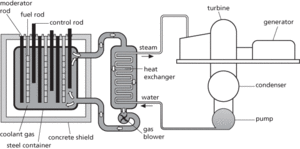A device in which a nuclear fission chain reaction is sustained and controlled in order to produce nuclear energy, radioisotopes, or new nuclides. The fuels available for use in a fission reactor are uranium–235, uranium–233, and plutonium–239; only the first occurs in nature (as 1 part in 140 of natural uranium); the others have to be produced artificially (see nuclear fuel). When a uranium–235 nucleus is made to undergo fission by the impact of a neutron it breaks into two roughly equal fragments, which release either two or three very high-energy neutrons. These fast neutrons need to be slowed down to increase the probability that they will cause further fissions of 235U nuclei and thus sustain the chain reaction. This slowing down process occurs naturally to a certain extent when the neutrons collide with other nuclei; unfortunately, however, the predominant uranium isotope, 238U, absorbs fast neutrons to such an extent that in natural uranium the fission reaction is not self-sustaining. In order to create a controlled self-sustaining chain reaction it is necessary either to slow down the neutrons (using a moderator in a thermal reactor) to greatly reduce the number absorbed by 238U, or to reduce the predominance of 238U in natural uranium by enriching it with more 235U than it normally contains. In a fast reactor the fuel used is enriched uranium and no moderator is employed.
In thermal reactors, neutrons are slowed down by collisions with light moderator atoms (such as graphite, deuterium, or beryllium); they are then in thermal equilibrium with the surrounding material and are known as thermal neutrons. In a heterogeneous thermal reactor the fuel and moderator are in separate solid and liquid phases (e.g. solid uranium fuel and a heavy water moderator). In the homogeneous thermal reactor the fuel and moderator are mixed together, for example in a solution, molten dispersion, slurry, or suspension.

Nuclear reactor. A schematic diagram of a gas-cooled reactor.
In the reactor core the fuel elements encase the fuel; in a heterogeneous reactor the fuel elements may fit into a lattice that also contains the moderator. The progress of the reaction is controlled by control rods, which when lowered into the core absorb neutrons and so slow down or stop the chain reaction. The heat produced by the nuclear reaction in the core is used to generate electricity by the same means as in a conventional power station, i.e. by raising steam to drive a steam turbine that turns a generator. The heat is transferred to the steam-raising boiler or heat-exchanger by the coolant. Water is frequently used as the coolant; in the case of the boiling-water reactor (BWR) and the pressurized-water reactor (PWR) water is both coolant and moderator. In the BWR the primary coolant drives the turbine; in the PWR the primary coolant raises steam in a secondary circuit for driving the turbine. In the gas-cooled reactor the coolant is a gas, usually carbon dioxide with an outlet temperature of about 350°C, or 600°C in the case of the advanced gas-cooled reactor (AGR).
In fast reactors, in which there is no moderator, the temperature is higher and a liquid-metal coolant is used, usually liquid sodium. Some fast reactors are used as converters or breeders. A converter reactor is one that converts fertile material (such as 238U) into fissile material (such as 239Pu). A breeder reactor produces the same fissile material as it uses. For example, a fast breeder reactor using uranium enriched with 239Pu as the fuel can produce more 239Pu than it uses by converting 238U to 239Pu. See also thermonuclear reactor.
http://www.world-nuclear.org/information-library/nuclear-fuel-cycle/nuclear-power-reactors/nuclear-power-reactors.aspx The website of the World Nuclear Association, an association of companies in the nuclear industry
A process in which nuclear energy is produced from a controlled nuclear fission reaction. The reaction takes place in the core and involves fissile materials known as nuclear fuel for which the common nuclear fuels are uranium-235 and plutonium-239. By slowing down fast-moving neutrons using a moderator such as graphite, the neutrons that strike the nuclear fuel results in the emission of other neutrons to form a chain reaction generating heat which is converted into electrical energy through steam turbines. The world’s first commercial nuclear power station at Calder Hall in the UK came into operation in 1956. It consisted of four Magnox reactors that were originally capable of generating 60 MW of electrical and thermal power. Named after an abbreviation for the magnesium oxide non-oxidizing cladding of the unenriched (i.e. natural) uranium fuel rods, the reactors were designed as pressurized carbon dioxide-cooled, graphite-moderated reactors. The reactors used boron-steel control rods. The power station was closed in 2003.
There are nearly 500 nuclear reactors in operations around the world and the most widely used is the pressurized water reactor (PWR). These nuclear reactors use water pressurized to around 160 bar to dissipate heat to achieve a high temperature and avoid boiling. The heat is transferred to a secondary system in a steam generator.
- Grignard, François Auguste Victor
- Grignard reagents
- grike
- Grimaldi, Francesco Maria
- Grimm–Sommerfeld rule
- grinding
- GRIP
- Grisebach, August Heinrich Rudolph
- grism
- Grissom, Gus (1926–67)
- grizzly bear
- GRM
- GRO
- groin
- grooming
- Grooved Terrain
- grooved terrain
- groove mark
- grosbeak
- Grosch’s law
- gross
- gross domestic capital formation
- gross domestic fixed capital formation
- gross domestic product
- gross drying rate